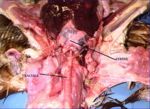Difference between revisions of "Syrinx - Anatomy & Physiology"
Jump to navigation
Jump to search
| Line 6: | Line 6: | ||
==Introduction== | ==Introduction== | ||
| + | Vocalisation is an important evolutionary ability of birds. The extend of song varies in different avian species from complex pitches, patterns and rhythms in song birds to the amusing squawk of penguins. Birds lack vocal folds and so sound is produced in the syrinx. | ||
[[Image:Syrinx Anatomy.jpg|thumb|right|150px|Anatomy of the Syrinx - Copyright RVC]] | [[Image:Syrinx Anatomy.jpg|thumb|right|150px|Anatomy of the Syrinx - Copyright RVC]] | ||
| − | ==Structure== | + | ==Structure and Function== |
*Specialisation of the trachea bifurcation | *Specialisation of the trachea bifurcation | ||
| − | * | + | *Located at the caudal end of the trachea and at the beginning of the primary bronchi |
| + | |||
| + | *Tracheal cartilages of the syrinx are complete and sturdy | ||
| + | |||
| + | *Bronchial cartilages are incomplete | ||
| − | * | + | *Paired sternotrachealis muscle pulls the [[Trachea - Anatomy & Physiology|trachea]] towards the syrinx |
| − | * | + | *Shape and size of syrinx varies between species |
| − | + | *Composed of ossified cartilages, vibrating membranes and muscles | |
| − | * | + | *Lateral and medial walls of the primary bronchi are membranous and flutter which produces sound |
| + | **Sound is produced on expiration | ||
| + | **Increased pressure in the clavicular air sac causes the tympanic membrane of the syrinx to be forced into the lumen and vibrate | ||
| + | **Tension of the membranes is controlled by the tracheolateral muscles | ||
==Vasculature== | ==Vasculature== | ||
| Line 40: | Line 48: | ||
==Species Differences== | ==Species Differences== | ||
| − | * | + | *Drakes and Cobs (male swans) have an enlarged osseous bulla on the left side of the syrinx which acts as a resonator |
| + | |||
| + | *Songbirds have a complex set of syringeal muscles | ||
==Links== | ==Links== | ||
Revision as of 11:45, 29 July 2008
Introduction
Vocalisation is an important evolutionary ability of birds. The extend of song varies in different avian species from complex pitches, patterns and rhythms in song birds to the amusing squawk of penguins. Birds lack vocal folds and so sound is produced in the syrinx.
Structure and Function
- Specialisation of the trachea bifurcation
- Located at the caudal end of the trachea and at the beginning of the primary bronchi
- Tracheal cartilages of the syrinx are complete and sturdy
- Bronchial cartilages are incomplete
- Paired sternotrachealis muscle pulls the trachea towards the syrinx
- Shape and size of syrinx varies between species
- Composed of ossified cartilages, vibrating membranes and muscles
- Lateral and medial walls of the primary bronchi are membranous and flutter which produces sound
- Sound is produced on expiration
- Increased pressure in the clavicular air sac causes the tympanic membrane of the syrinx to be forced into the lumen and vibrate
- Tension of the membranes is controlled by the tracheolateral muscles
Vasculature
Innervation
Lymphatics
Histology
Species Differences
- Drakes and Cobs (male swans) have an enlarged osseous bulla on the left side of the syrinx which acts as a resonator
- Songbirds have a complex set of syringeal muscles
